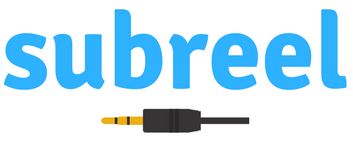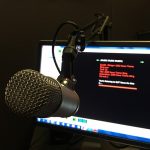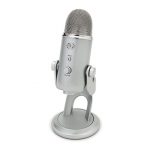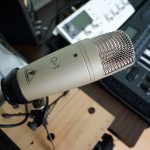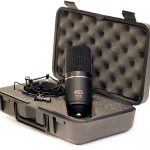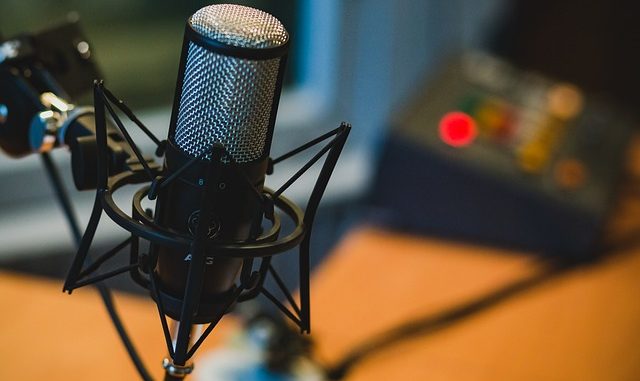
Podcasting is growing all the time. Most of us have the means to listen to podcasts on our phones, laptops, tablets, and iPods, but we also all have the ability to create our own podcasts on the same devices. All you need is to get your hands on one of the top microphones for podcasting and a way to connect it to your laptop or other devices to make a recording. There is a lot of choice out there, and mic terminology can quickly get confusing. In this article, we look at the best podcast microphones including USB and XLR connected microphones.
Head Straight to Our Recommended Podcast Mic
Podcasting Mic Reviews
Portable Microphone for Podcasting – Samson “Go”
The Samson Go markets itself as a ‘portable USB condenser microphone’. In that respect, it fits the bill for most podcasting purposes. Podcasting is a difficult thing to get right, sometimes we need to make recordings when out and about, and with the Samson Go it is as easy as getting it out, flipping the built-in stand and starting to record.
I’ve seen the Samson Go on sale for less than $50 at times, which is very cheap in the world of audio gear. This price point brings some limitations, and the Samson Go isn’t going to record any number one albums in a hurry, but for an easy, affordable option to get started it is hard to argue with.
Features:
- Cleverly designed stand/clip which can clip onto your laptop or can stand independently on a desk or table.
- Compatible with both Mac and PC, simply plug it in and you’re good to go.
- Switch between cardioid and omnidirectional pickup patterns. Omnidirectional is great for multiple voices, the cardioid is perfect for recording one voice.
- 1/8″ stereo output for headphones, which means you can monitor your recordings with no latency.
I’m not going to claim that the quality of recording from a Samson Go is as good as that from a mic that costs four or five times as much, but it is a huge upgrade on a phone microphone for instance.
Samson microphones aren’t the biggest brand in the industry. Brands such as Shure, Rode, and AKG are the biggest players. Samson does offer some very good drum microphones but the ‘Go’ model is definitely designed for recording voices. Hence its suitability for podcasts.
It may well be the most portable mic we’ve come across and the fact that it is easy to use is another huge bonus. Great for those taking their first baby steps into podcasting.
The Best “Cheap” Podcasting Mics
Cheap is very much a subjective term, but there are some microphones on the more budget end of the market that do a very good job. These are great for beginners and hobbyists, and if used properly can create audio recordings which can hold up to professional standards.
Blue Microphones Snowball
Blue Microphones can be seen in the studios (and home studios) of musicians and podcasters everywhere. The brand is one of those which has pushed the envelope with USB technology and made it viable for recording. 10 years ago, USB microphones were very poor compared to those we have today, and their Snowball and Yeti mics have played their part.
In terms of features, this offers much the same as the Samson Go, but in my opinion records with a little more clarity and fidelity. Just like the Go, the Blue Snowball has cardioid and Omnidirectional modes but also has a -10 dB recording mode which can be great for louder audio sources.
It plugs in with ease and you can be ready to record in a few short minutes. This is also pretty portable and easy to take out and about, so ticks most of the boxes for an affordable USB mic without all the bells and whistles some of its competitors boast. The Snowball is probably marginally preferable to the Samson mic, just because of its upgrade in audio quality.
MXL 770 Cardioid Condenser Microphone
MXL is a brand which has started to make waves. Created by Marshall electronics, this is another mic which isn’t too harsh on the pocketbook. The 770 is a condenser microphone with an XLR connector, so you will need to use an audio interface or preamp of some description to plug it into a laptop, but if you have a little knowledge of audio or electronics this shouldn’t be too much of an issue.
This microphone has become popular for rappers and other vocal applications. It can be used for instruments too and the versatility of the microphone combined with the immense value for money means it makes our list of the best podcast mics.
The MXL 770 comes with a cradle, and fitting it into a microphone boom arm or mic stand is relatively simple. This makes it less likely that little bumps and movements will be picked up on the mic and ruin your interview and gives a more professional feel while making your recordings. The cardioid polar pattern means that the MXL 770 is best for recording one voice or instrument.
A low-end roll-off option means that you can clearly pick up the frequencies you need without getting any unwanted rumble in the low end. The microphone requires 48v of phantom power which can be provided by audio interfaces or mixing desks.
This is a well-made microphone wired with Mogami electronics. The audio clarity is great and the polar pattern and frequency response really lend themselves to clear vocal recordings, perfect for interviews and monologues for podcasts.
The MXL 770 has a ‘bigger’ sibling, the 770X. If you can afford the upgrade, we definitely recommend this mic, and it will give you more flexibility with your podcasting. This model has a figure of eight and omni polar patterns and comes with a pop shield and more accessories. The MXL 770X is built with a gold-sputtered diaphragm and you can definitely hear an upgrade in clarity between this and the standard 770. Both make great options for different price ranges.
Audio-Technica AT2020 (or Audio-Technica AT2020USB+)
A microphone available in either USB or XLR connections, so you can use whichever you are comfortable with. This offers 16 bit and either 44.1 or 48 kHz sample rate, this means clear, CD quality audio. There is even a more advanced model for even more clarity and quality, but this costs a little more as you would expect.
Another great feature is the headphone output, which allows you to monitor in real-time with no latency, so you will be able to rest assured you are getting a strong and clear audio signal. This also comes with the accessories you will need including a stand which will sit on your desk, the cable you require, and a connector so you can connect this to a mic stand or boom arm with ease.
The USB model is a ‘plug and play’ mic, and therefore exceptionally simple to set up. As well as this it is compatible with both Mac and PC, so whichever operating system you go for won’t cause problems.
In terms of price, this is what we could call a ‘midrange’ microphone. In fact, many industry standard microphones are three or four times this cost, so it is suitable for beginners or home recording. Don’t let that fool you though, it is still excellent quality and responds well not only to voice recordings, but instruments like guitar and piano too.
Shure SM58
Shure’s SM57 and SM58 microphones are potentially the most popular microphones ever. They are especially popular for live applications, but the fact that they are so robust and so versatile means that pretty much every studio you go in has at least experimented with SM58 and SM57s.
These are dynamic microphones, and for Podcasts, we recommend the SM58 as it is designed to handle vocal frequencies very well. More than 50 percent of the time when you see live singing on stage, it will be being picked up with one of these, or a copy of the SM58. For studio use, they aren’t as popular, but for their well-rounded ability and rigorous build quality these will do a fine job for a lot of podcasters. There is no way a microphone can be this popular without having something to offer. The SM58 is an XLR connected mic, so will need to be run through some sort of audio interface.
Rode Procaster Broadcast Dynamic Vocal Microphone
RODE are a brand who have come a long way in the last 20 years or so. We simply couldn’t make a list of great podcast mics without including the ‘Procaster’, a mic designed for broadcasting and spoken word applications, and made with an exceptional amount of quality and detail. This has been tailored
This is a dynamic mic and can be used for broadcasting live or recording. The polar patterns are cleverly tailored for recording the frequency ranges of voices. It offers built-in noise rejection for ensuring that unwanted background noise is gone. The Procaster also has a pop-filter built in, this will help avoid plosives and sibilance creeping into your recordings.
It is much more of a luxurious, professional quality microphone than some of the others, and the package it comes with backs this up. It has a stand mount, case/pouch, and an internal shock-mounted capsule so that handling noise (the noise of the mic moving around) is as low as possible.
If you are looking for the best product you can get, this is one of the top realistic options. There are better microphones out there, you could argue that using an industry-standard vocal mic such as the Neumann U87 would do a better job, but actually, I think that is a bit of ‘overkill’. The fact that this microphone has been created purely with podcasting and broadcasting in mind makes it one of our top choices. With a huge amount of five-star reviews and pro podcasters and audiophiles raving about the Procaster, it comes strongly recommended, but not for those on a tight budget.
CAD GXL2400 USB Microphone
Another of the more affordable mics out there. CAD is a brand which has for a long time made budget microphones. They’ve recently ventured into USB microphones, and some of their models are superb for use on a podcast. The GXL2400 USB mic is designed with vocal frequencies in mind and has become a popular microphone for gaming and podcasting because of this.
This kit comes with all you need to get going. Not only does it have the plug-and-play capability provided by USB. On top of that, this has a small desk stand built in, and even a shock mount to ensure the capsule doesn’t get jolted and provide any nasty noises which ruin your recording.
The Akos capsule which is built into this microphone is superb quality for the price range, with many reviewers claiming you won’t find better at this sort of price range. The impressive average reviews and reception from consumers everywhere back up our opinion that CAD has hit a home run with such an affordable but good quality microphone. Perfect if you’re shopping for a podcasting mic under $100.
Podcast Recording Tips
XLR or USB
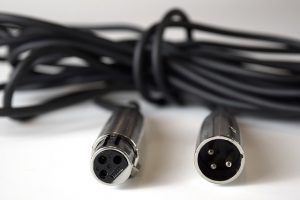 This is a massive debate in the world of podcasting. There is no denying that USB microphones are super easy, and the technology has grown a huge amount in the last 10 years or so. The truth is, if you’re just getting started then a USB microphone will be your simplest route to clear audio.
This is a massive debate in the world of podcasting. There is no denying that USB microphones are super easy, and the technology has grown a huge amount in the last 10 years or so. The truth is, if you’re just getting started then a USB microphone will be your simplest route to clear audio.
The debate rumbles on regarding USB vs XLR, Shure have waded in and described the claim that XLR is superior as a ‘myth‘. It certainly can be a myth. The worst XLR mic would easily be worse than a mediocre USB microphone.
XLR is wonderful technology and has been the mainstay of the music industry for many decades. If you already have an XLR mic or you decide that you will be buying one of these, you will need some sort of audio interface to run it through. This will take the signal from the XLR connection, amplify it and feed it into your computer. You can alternatively use a mixing desk.
Recommended Audio Interface for Podcasting:
Focusrite Scarlett Solo
The Focusrite Scarlett Solo is now in its second iteration and has a preamp built-in, which boosts the signal and creates a clear and crisp audio sound. It only has one input, but for most podcasting that is all you will need. Focusrite makes a model with two inputs too, so if you do want to set up with two microphones, for instance in an interview scenario, this is possible.
Clear audio, easy to set up and this product often comes bundled with the Protools DAW. This makes it easy to start out editing podcasts too.
Lapel and Lavalier Microphones
It is important to mention Lapel and Lavalier mics for podcasts too. These are mics you may associate with news broadcasts and interviews, the tie-clip style mics designed for picking up voices at close range. If you are doing an interview-style podcast, it can be a really useful way to record multiple voices without one being louder than the other. Often these will plug into a dictaphone or digital portable recorder, or even into a phone or iPad, and make the whole process much easier. It may even be the case that you have this kind of setup when you go out and about recording interviews, and a different home recording setup.
We have a full list of our pick of Lapel/Lavalier microphones here.
Recording Environment
It may be common knowledge to some, but it is worth mentioning that the microphone you use to record your podcast is only as good as the space you’re recording in. Don’t record your podcasts in an echo-chamber of a bathroom. Try and avoid wind, street traffic, and other interruptions, and think of these when selecting your mic and accessories. If you have a podcast whereby you have to do recordings outside, get yourself a windshield. If you are recording at home, put up some acoustic treatments to create the best environment possible.
More great podcast recording tips from one of the best business podcasters, Pat Flynn, are in the following video:
What to Look For in a Podcast Microphone
There are a few criteria for choosing a good mic for podcasting, it isn’t just a case of a simple search for any old microphone, some will do a far better job than others and some will need more knowledge of audio technology to use.
- USB vs XLR. These are the two most common choices for podcasting mics, a USB microphone is a very simple option, with many also compatible with phones and tablets so you can record straight onto these if you wish. XLR mics are more common and some argue they are better quality, but they need to be used via an audio interface or mixer which can make your life a little more tricky.
- Condenser or Dynamic mic? The truth is that either can do a good job. To put it simply, condenser mics tend to pick up more detail in audio whereas dynamic mics can be more rugged and take more of a beating.
- Pickup patterns. Different pickup patterns mean picking up audio from different areas. Sometimes, different pickup patterns can be preferred for recording in different situations, for example, an omnidirectional microphone can record from all angles, great for recording a group conversation. Many microphones have multiple pickup patterns, commonly cardioid, which you can choose between.
- Value for Money. The cost is always going to play a part in a decision for buying podcasting gear. If you are a beginner, you may not want to spend a fortune on a microphone when making your beginner steps.
Our podcast microphone reviews take all of the above into consideration when recommending products. Both USB and XLR models are mentioned, and we’ve included different options for different price ranges. The majority of podcast mics here are under $200, with some products available under $100.
Conclusion
Podcast statistics show that this medium is growing all the time. Most people in the USA and elsewhere are now familiar with them, making them a platform for all sorts of entertainment, news, and media. It is estimated that nearly half of the US population have listened to podcasts, and making your own can be as simple as setting up a mic and speaking! This infographic from Entrepreneur mag shows just how important they can be. Podcasts can be a great way to promote yourself, your business or even make money through advertising and sponsorship.
As a wise human once said, there are many ways to skin a cat. When listening to podcasts in preparation for this, I realized that no two podcasters seem to have identical ways of doing things. Fortunately, the amount of products available now means that you can do things your own way, but getting some basics nailed down is a good start. Depending on your budget and knowledge of audio equipment, the products we’ve mentioned shouldn’t see you go far wrong.
If you are a beginner looking for a simple start and not wanting to spend a lot of money, one of the USB models with plug-and-play connectivity for both PC and Mac could be just what you need. If you’re looking for the very best money can buy, the Procaster can do a wonderful, professional job.
We’d love to hear your podcasting setup. Mic, accessories and more, drop us a comment below and let us know how you’re getting results.
